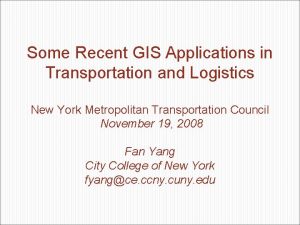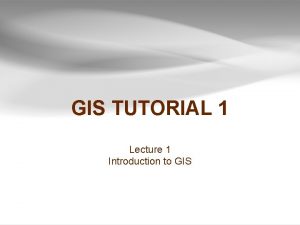GIS Speaks for Trees GIS Applications in Tree

- Slides: 1

GIS: Speaks for Trees GIS Applications in Tree Maintenance Geography 357 E-poster Janet Beekman Pro’s: How can Geographic Information Systems speak for trees? Knowing that a tree contains a cable can - Easily search tree database. - Can determine what is near by. - Data is easily shared by many people. prevent injury to the worker who is planning on removing a limb of the tree. Removing limbs of trees with risk assessment can prevent injury to the public. GIS speaks for trees by making it easy to keep track of and to find information about trees. In the example to the left, arborists at Penn State University are using GIS to keep track of which trees out of over 12, 000 need risk assessment, which trees have cables in them, and where a given tree is located. Con’s: - Expensive - Expertise required - Requires some to change The city of San Luis Obispo California uses GIS to show the public where their Heritage Trees are located. Applications The GIS can be searched to find a particular type of tree and to get more information about it. Inventory Penn State Tree Maintenance Server http: //lorax. opp. psu. edu/treemaintenance A Penn State arborist can also use GIS as shown on the left to maintain growth statistics on a tree as well as maintain and review its health record. Health Record Heritage Trees of San Luis Obispo http: //maps. slocity. org/website/trees The figure to the left shows information about a Japanese Maple Heritage Tree of San Luis Obispo. A GIS was used to find this information. Risk Assessment Public Information Disease Monitoring Health Record for Tree O 3 in the Penn State Tree Maintenance Server http: //lorax. opp. psu. edu/treemaintenance Oak. Mapper Monitoring SOD using Web. GIS http: //kellylab. berkeley. edu/SODmonitoring/Oak. Mapper. htm In central costal California many types of Oak trees are dying of a disease called Sudden Oak Death(SOD) which is cause by a fungus. This fungus affects many other types of trees and shrubs. Here, GIS is used to monitor the trees with SOD to learn about it’s distribution in California. Japanese Maple Heritage Tree of San Luis Obispo http: //maps. slocity. org/website/trees/maple With the form on the left, a person in California can report a tree they think has signs of SOD, note symptoms, and report it’s location. Sources City of San Luis Obispo(2004), Heritage Trees of San Luis Obispo: http: //maps. slocity. org/website/trees Accessed January 23, 2005 Trees of Penn State: http: //lorax. opp. psu. edu/treemaintenance Accessed January 23, 2005 University of California-Berkeley(2003), Monitoring Sudden Oak Death: Oak. Mapper Tree Submittal Form http: //kelleylab. berkeley. edu/Oak. Mapper/submittal/default. htm http: //kellylab. berkeley. edu/SODmonitoring/Oak. Mapper. htm Accessed January 23, 2005

